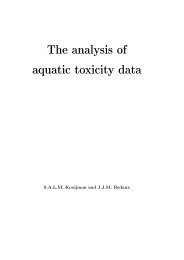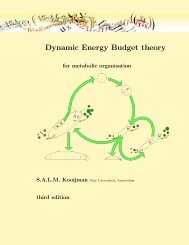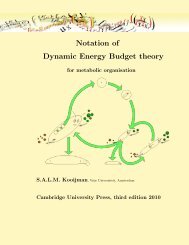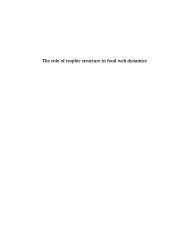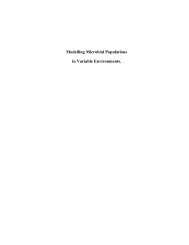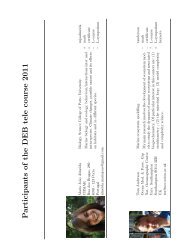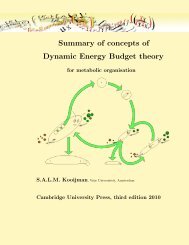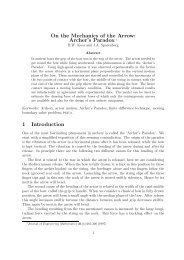Archery and Mathematical Modelling 1
Archery and Mathematical Modelling 1
Archery and Mathematical Modelling 1
Create successful ePaper yourself
Turn your PDF publications into a flip-book with our unique Google optimized e-Paper software.
”(2) Upon release, the bowstring imparts its energy to the arrow more uniformly<strong>and</strong> at a higher <strong>and</strong> more sustained rate of thrust than in a ordinary bowwithout siyahs.”This statement is not supported by the results obtained with the model. Because ofthe relatively heavy ears, there is a sudden decrease in the force in the string <strong>and</strong>, byimplication, in the acceleration force upon the arrow. The result of this is oscillatorybehaviour as shown in Figure 4. Consequentially the efficiency of static-recurve bows arather low. The amplitude of the oscillations depends largely on the modulus of elasticityof the string <strong>and</strong> the mass of the arrow relative to the mass of the ears.”(3) When the bow string reaches the bridges it is in effect shortened, increasingthe tension again on the bowstring <strong>and</strong> giving the arrow a final snap as it leavesthe bow.”The dynamic force draw curve (E in Figure 4) shows that the acceleration of the arrow israther large when the string has contact with the bridges.Notwithst<strong>and</strong>ing this, the efficiency η of the PE-bow <strong>and</strong> certainly that of the TUbow,is rather low. This implies that the initial velocity ν is not as large as one wouldexpect on the basis of the static performance. This is caused by the relative heavy ears.These considerations demonstrate why these bows can, inherently, not be better than longstraight-end bows. A large part of the available energy remains in the vibrating limbs <strong>and</strong>string after arrow exit.This holds even to a larger extent for the ER-bow. The string cannot slow down thenow light ends of the limbs during the final part of the acceleration of the arrow when thebow is close to its braced situation again.The modern WR-bow seems to be a good compromise between the non-recurve bow<strong>and</strong> the static-recurve bow. The recurve yields a good static quality coefficient <strong>and</strong> thelight tips of the limbs give a reasonable efficiency.5 Construction of the bowBut what made the Turkish flight bow a superb type of bow for flight shooting? Until nowwe dealt with the mechanics of the bow but not with its construction. The efficiency isgreatly affected by the relative mass of the arrow relative to that of the limbs. For a fixedmass of the arrow, the lighter the limbs the better the efficiency. This is the item wheretechnology becomes important. The minimum mass of the limbs for a fixed weight <strong>and</strong>draw is determined largely by the appropriateness of the material to store energy.In the past man used bows which differ not only in shape but also in the materialsapplied. Simple bows made out of one piece of wood, straight <strong>and</strong> tapering towards theends have been used by primitives in Africa, South America <strong>and</strong> Melanesia. In the famousEnglish longbow the different properties of sapwood <strong>and</strong> heartwood were deliberately putto use. Eskimoes used wood together with cords plaited of animal sinews <strong>and</strong> lashed to thewooden core at various points. The Angular bow found in Egypt <strong>and</strong> Assyria are examples8





